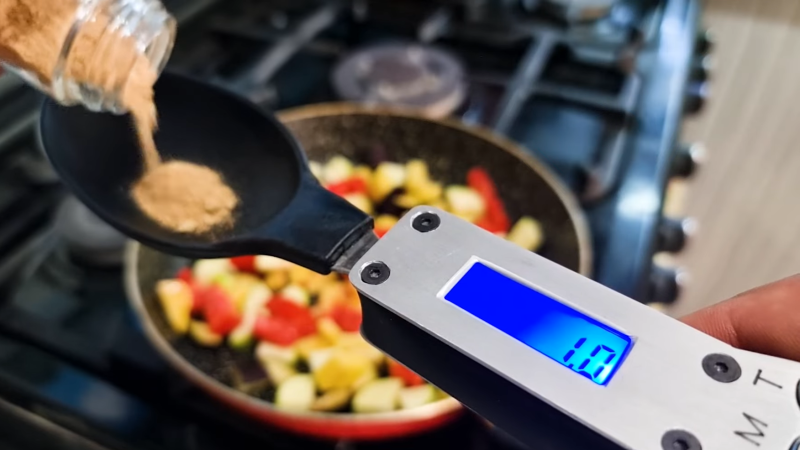There seem to be two camps when it comes to recipes: those based on volume-based measurements, and those based on the weight of ingredients. Gravimetric measurements have the advantage of better accuracy, but at the price of not being able to quickly scoop out a bit of this and a dash of that. It would be nice to get the convenience of volumetric measurements with the accuracy of weighing your ingredients, wouldn’t it?
It would, and that’s just what [Penguin DIY] did with this digital kitchen spoon scale. The build started with, perhaps not surprisingly, a large mixing spoon and a very small kitchen scale. The bowl of the spoon got lopped off the handle and attached to the strain gauge, which was removed from the scale along with its LCD display and circuit board. To hold everything, a somewhat stocky handle was fabricated from epoxy resin sandwiched between aluminum bolsters. Compartments for the original electronics parts, as well as a LiPo battery and USB charger module, were carved out of the resin block, and the electronics were mounted so that the display and controls are easily accessible. The video below shows the build as well as the spoon-scale in action in the kitchen.
We think this is not only a great idea but a fantastic execution. The black epoxy and aluminum look amazing together on the handle, almost like a commercial product. And sure, it would have been easy enough to build a scale from scratch — heck, you might even be able to do away with the strain gauge — but tearing apart an existing scale seems like the right move here.

















Seems like an awful execution to me – its a kitchen good which means the spoon part at the very least has to be properly washable, so it really needs to be disconnectable if the whole thing isn’t washable (which it isn’t). And when you are using so much epoxy anyway why not throw in a wireless charging pad and encapsulate all the electronics in the first place – one of the very few cases where entirely encapsulated supremely annoying to fix electronics actually makes sense!
Not going to be particularly precise either – though for culinary purposes more than sufficient.
Do really like the idea though, give it quick change tool heads and it could be really neat. The only other thing I think I would change is the spoon for me aught be a slightly different shape so it can have some markers in it for common fluid volumes as well – for those recipes that tell you 1tbs of this and 2 grams of that. Nothing more annoying that trying to guess or look up the density of something odd like salt… Though again that is just the slightly OCD chemist in me, as for cooking if it says 20g it probably means over 5 and less than 40 will work fine in most cases, its just not precise. I like precise.
You forgot the don’t bother measuring camp.
Agree. An eyeball calibrated by experience makes for tastier food, IMNSHO ;)
I can imagine someone making “tap-tap-tap” in the border of the bowl…And “crack”
People with PKU and their parents would love this. Add a button so it reports in the weight. Then open an app and select the ingredient and calculates the phe.
Imperial vs. the rest of the metric world. The whole spoon and cup thing turned me off a long time ago over the lack of a weighing scale.
Using the absolutely precise and accurate method of holding a ruler up to my laptop screen when the drawing is shown, the short, cantilevered spoon mount and large spoon bowl looks like a huge leverage problem: 50 grams on the tip of the spoon bowl will give (very) roughly the same measurement as 150g at its base near the neck.
I had the same feeling. This inventor should have attended the physics classes at high school. What a pity!
Impressive re casing, but, aren’t scales suppose to be leveled? Like, if you turn on the spoon and then slightly incline it, the measure will have an error because force is applied differently
These are already a “thing” for USD $5 including delivery from China. There are other ways of cooking that suit a traditional scale better, e.g. when loading up a bread machine you put your ingredients into the pan in order and you watch the accumulated weight, the rise for each step/ingredient is written down in a sequence. However you can combine the two methods and have the digital scoop ensure that you are in the ballpark to prevent you having to go back for more. Measure twice and bake once, and all that…
These are indeed cots products.
A link for the lazy folks:
https://duckduckgo.com/?q=weight+scale+spoon&t=ha&va=j&iax=images&ia=images
When I’m cooking, generally weight is used for large portions/quantities and spoons (as in measuring) are used volumetrically. So, aside from some medical applications, like the previously noted PKU, this item falls into my “solution looking for a problem” category. That said, it may be useful for some of my ceramics & glaze preparations that do use small, weighed, quantities. So, OK in the studio, not so in the kitchen.
This seems like a great tool for portion control! I think we all know people who for whatever reason need accurately sized portions, whether for medical reasons, dietary, or what have you. An improvement might be adding the ability to add up consecutive measurements for a cumulative reading.
I see nobody has bothered to build a spring-loaded holder clamp into these scales so one can fit regular spoons and release them into the dish washer with single-handed operation.
Until next time…